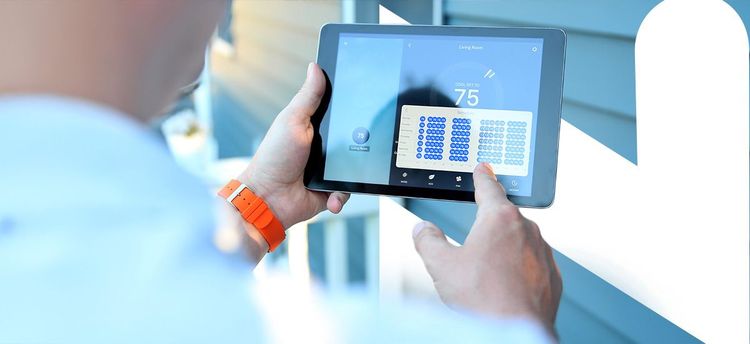6 Feb 2025

Maximizing home energy efficiency can help you take an important step toward reducing your carbon footprint and creating a more sustainable environment. The good news is that switching to a more sustainable lifestyle doesn't require many considerable changes. Sometimes, combining smaller adjustments can make a significant difference in your overall energy consumption.
If you're curious about boosting your home's energy efficiency, explore our guide below to discover essential tips and strategies.
According to the Environmental and Energy Study Institute, “energy efficiency” involves using less energy to perform the same task. This means that when your home is energy-efficient, it provides the same level of functionality and comfort you previously had while using less power. Striving to have an energy-efficient home comes with many advantages, such as:
Ready to begin your journey to a more energy-efficient home? These six energy-efficient home tips will help you take the first steps toward reducing home energy costs and improving sustainability.
Start by assessing your current energy consumption levels. Understanding the state of your home's energy usage will help you identify where you may be wasting energy and areas where you can improve.
This audit typically involves inspecting your home's systems, insulation, air sealing and appliances. You can contact a professional energy auditor to help thoroughly evaluate your house. For a DIY home energy audit approach, you can:
Insulation and air sealing help regulate your home's ambient temperature by reducing heat transfer through ceilings, floors and walls by sealing gaps and cracks. Implementing these two techniques is one of the best low-cost ways to save energy at home, as it can help improve comfort levels and reduce heating and cooling expenses.
Begin by evaluating your home's insulation and determining where insulation may need to be upgraded or added. You can also locate areas that may need to be sealed, such as gaps around plumbing systems or window frames. Use your preferred sealant, such as caulk or weather stripping, to seal the cracks.
Energy-efficient appliances incorporate advanced features and technologies that help reduce electricity consumption and environmental impact. Since they’re designed to consume less energy, they can naturally help lower home energy costs over time.
Prioritize ENERGY STAR-rated appliances, which indicate more energy efficiency than standard models. These include washing machines, air conditioners, water heaters, refrigerators and other everyday home appliances.
Light fixtures are another key part of maximizing home energy efficiency. Traditional incandescent lights convert most of the energy they consume into heat. However, new lighting technologies such as LED bulbs can help reduce energy consumption while also lasting longer. LEDs also offer benefits like:
Consider pairing your new bulbs with a smart lighting system that operates your lights on a schedule. They'll automatically turn on and off as needed, such as when you arrive home, to help you reduce energy usage and save costs.
Since your home's heating, ventilation and air conditioning (HVAC) system has a big impact on your home and its occupants, you want to make sure it works well — but you also want to lower its energy use as much as possible. HVAC systems rely on considerable energy to operate, but you can take steps to optimize them.
Optimizing this system can involve upgrading to energy-efficient alternatives and practicing proper maintenance. Have your system serviced consistently by a qualified technician, and consider replacing outdated components. Change the filters regularly to streamline airflow and reduce blockages.
Implementing a smart thermostat can also be beneficial. Smart thermostats help optimize your heating and cooling schedules by adjusting the temperature when necessary. For example, you can set the thermostat to automatically adjust temperatures based on when you're home and out of the house.
In addition to helping you create an energy-efficient home, optimizing your heating and cooling can also help with:
Implementing renewable energy options involves using sustainable energy sources such as wind, hydropower or solar panels for home energy savings. According to Statista, fossil fuels account for over 80% of primary energy consumption worldwide. Reducing your reliance on traditional, fossil fuel-based electricity will decrease your carbon footprint and even help you save costs.
Think about the advantages and considerations of different renewable energy options in your area. Solar power is a popular, effective choice for many homeowners, but other options may be more suitable for your needs. With the right energy partner on your side, switching to sustainable energy to power your home is simple and easy.
Northeastern Power is a licensed, integrated energy retailer for eco-conscious homeowners in New York. We're here to help you transition to a more sustainable home. We offer electricity, natural gas and sustainable solutions for commercial, industrial and residential customers. You can choose from wind, solar and hydroelectric power. In addition, we offer green residential electric solutions like demand response programs and energy storage systems. We also provide personalized plans to help you get a plan that best aligns with your sustainability goals.
Contact our team today to learn more about how we can help you achieve an energy-efficient home.
Linked Sources: https://www.eesi.org/topics/energy-efficiency/description https://nepower.com/blog/Advantages-of-Renewable-Energy https://www.energy.gov/energysaver/reducing-electricity-use-and-costs https://www.nar.realtor/magazine/real-estate-news/sales-marketing/energy-efficiency-will-help-drive-future-property-value https://www.nyserda.ny.gov/All-Programs/Inflation-Reduction-Act/Inflation-Reduction-Act-homeowners https://www.energystar.gov/products/products-list https://www.energy.gov/energysaver/led-lighting https://www.epa.gov/indoor-air-quality-iaq/introduction-indoor-air-quality https://nepower.com/blog/History-of-Renewable-Energy https://www.statista.com/topics/12792/fossil-fuel-dependency-worldwide/#topicOverview https://nepower.com/about https://nepower.com/residential/energy https://nepower.com/contact